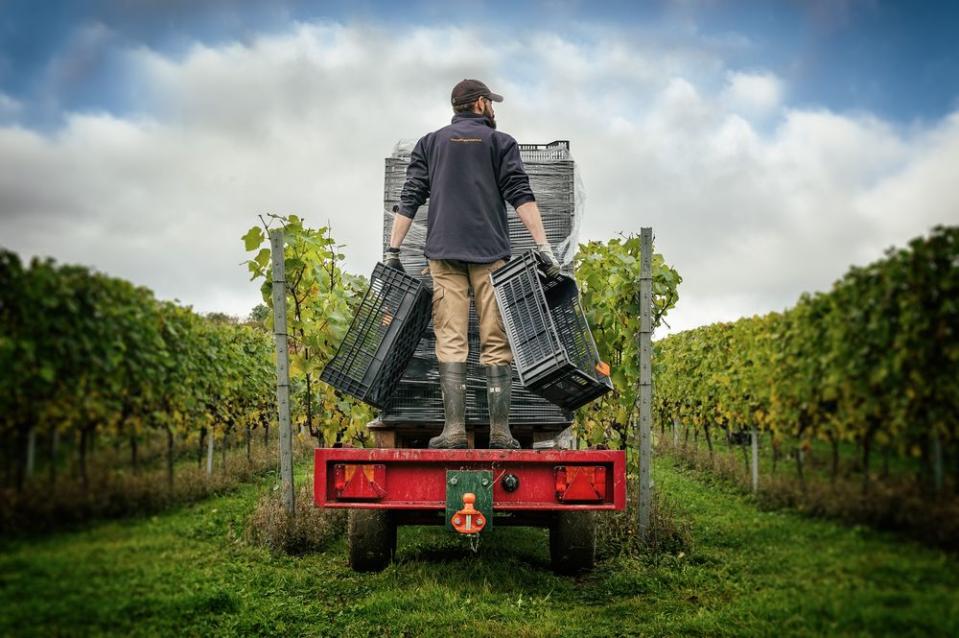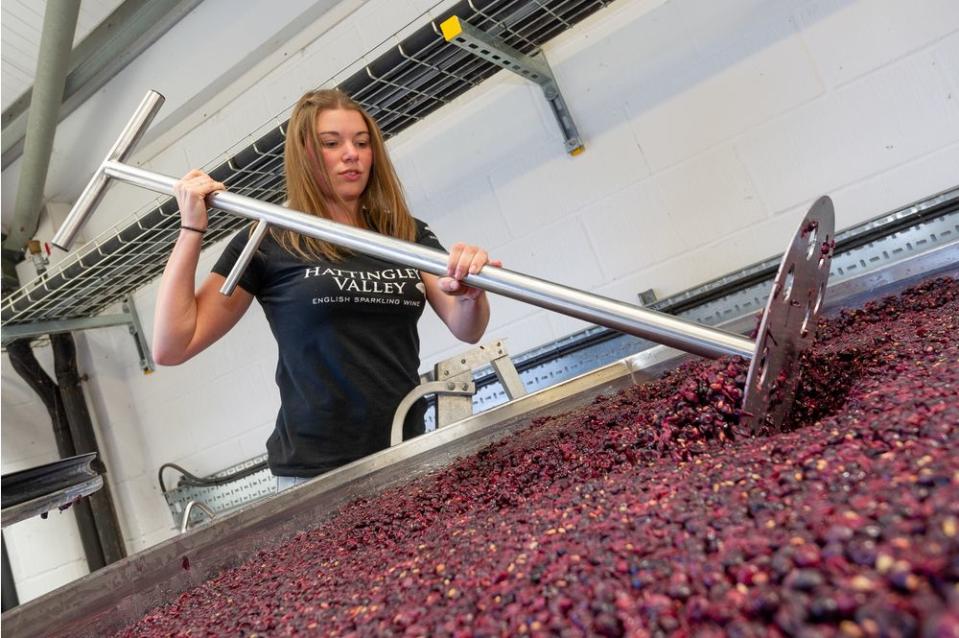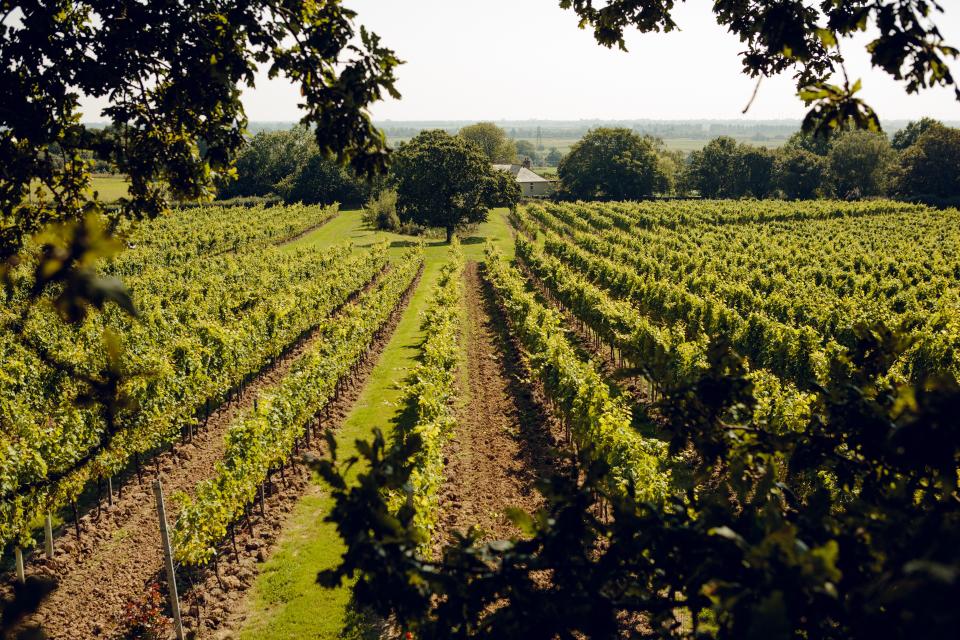English and Welsh Sparkling Wines Are Sparking a New Wave for Bubbles
When thinking of sparkling wine regions, locales like Italy (prosecco), Spain, (cava), and France (Champagne, of course), are usually top of mind. Certainly, there are numerous producers of sparkling wine around the world, but the next big hotspot for bubbles might not be somewhere you’d first expect—for any kind of wine.
England has been producing wine as far back as Roman times, but it has never quite burst through as a leading producer of wine or a destination for wine lovers. A great deal of this has to do with climate, as the country’s famously cold, damp climate is not ideal for vineyards. But climate change already going into effect has spurned numerous changes for wine growers worldwide, ranging from smaller adjustments involving harvest schedules to combatting full-on wildfires and other natural disasters threatening to tear down entire businesses. All of this, and more, has also opened up a new era for winemaking both in England and Wales.
“Global warming has enabled riper fruit in England. We now have the average growing temperatures that Champagne had some 30 years ago,” says Duncan Brown, head of export and travel retail at Gusbourne Estate, an award-winning English sparkling wine producer in Kent. “The market growth started in the 1990s when the pioneers of Traditional Method English Sparkling Wine (ESW) started to measure up favorably to Champagnes in blind tastings and wine competitions. Being an agricultural product, and one that requires long lees aging, the industry has been playing catch-up with growing demand ever since; the 2018 vintage may be the first one which will enable some sort of matching of production to demand.”
The United Kingdom is one of the world’s top markets for wine consumption, although the vast majority of it is imported. Sales for sparkling wine in the U.K. are on average quite high, with more than 100 million imported fizzy bottles sold annually. Still, the English and Welsh sparkling wine regions have been enjoying strong growth in recent years. Although historically the English wine market alone has only accounted for roughly 1% of the domestic market in the U.K., that number can only go up form here as a WineGB survey earlier this year highlighted more than 3 million vines had been planted between 2016 and 2018, with over two million being planted in 2019. This represents an increase of over 30% in planted area, and planting is still unrestricted.

The core of the sparkling wine industry is situated in the Southern counties—to the south and east of London—particularly Kent, Sussex, and Hampshire, as those sites are where the climate is most favorable. But wine is made in other areas as well—even as far north as Yorkshire. Norfolk, and Essex. There are roughly 500 vineyards and 165 wineries at present. Most vineyards are very small, but approximately 30 of them operate at a commercial scale. About 70% of the wine being made is sparkling wine—almost all of which is white or rose—although there is a smattering of red sparkling wine producers.
“The sparkling wine market started to emerge about 25 years ago, and it has gathered pace ever since,” says Simon Robinson, chairman of Wines of Great Britain (WineGB), the national organization for the English and Welsh wine industries. “Wine had been made in Britain since the early 1950’s, but until 25 years ago, it was largely still wine made from North German varieties.”
Robinson, who also founded also founded Hattingley Valley Wines in 2008, says recent shifts boil down to a few factors, including a steady rise in average summer temperatures over the last four decades, an influx of skilled winemakers and viticulturists, and greater investment in the English and Welsh wine industries—some of which, as Brown notes, comes from established Champagne houses, like Taittinger and Vranken-Pommery. Robinson also underscores a realization among winemakers in the region to follow the méthode traditionnelle and make sparkling wines from classic Champagne varieties (i.e. Chardonnay, Pinot Noir, and Pinot Meunier) as the climate and terroir is very similar to the Champagne region of France just a few hundred miles south.
“The chalk formation underlying Champagne stretches north, under the English Channel, and emerges along the south coast, and this formation is a critical component of the industry’s success,” Robinson explains. “The terroir, coupled with the long cool growing season, leads to classic cool climate wine: very fresh acidity, minerality, and often a yeasty, bready flavor with hints of green apples and citrus. Rosé wines often show red fruit, strawberries, and cream flavors as well.”

Sales of sparkling wine naturally lag production due to the nature of the product, Robinson explains, and because almost all of it is made in the traditional method, it is consequently held on lees between nine months and five years. The WineGB survey suggested English and Welsh wineries sold roughly 2.9 million bottles in 2018, 70% of which was sparkling. The majority was sold domestically, but larger wineries are increasingly looking to export their products. English and Welsh wines are exported to at least 40 countries, with the United States being the largest overseas market. Hattingley Valley in Hampshire, for example, became the first English wine to be distributed nationally in the U.S. last fall, and it is available in at 420 Whole Foods stores across 43 states. There has also been a significant uptick in sales being made in Australia, Scandinavia, and Japan. Overall, the industry made approximately 5.9 million bottles in 2017, a figure to which Robinson says was adversely affected by frost in 2017. But thanks to exceptionally favorable climatic conditions the following year, production increased to approximately 15.6 million bottles in 2018.
England and Wales are not the only growing regions lesser known for wine but catching notice with sommeliers and wine directors looking for the next big thing. Eastern Europe is on the forefront with a number of dynamic new wineries, and more North American regions are gaining traction from vineyards on the Niagara Peninsula of Ontario, Canada to the Finger Lakes and North Fork of Long Island in New York state just a few hours to the southeast.
Emily Wines (yes, that is her actual last name), a master sommelier and vice president of the wine and beverage experience at Cooper’s Hawk Winery & Restaurants across dozens of U.S. states, is responsible for advancing team members’ knowledge of wine and enriching guests’ experiences through education, which often means tearing down a lot of elitist attitudes about wine while offering things that are both new and accessible.
“There are a lot of exciting emerging and rediscovered regions right now. Some of them are quite old, but for the first time, they are making wines to be shared with the world rather than keeping them for local consumption only. Some of this is also due to improvement in quality and financial investment that allows for larger production,” Wines says. “Georgia is a great example of that. As the cradle of wine making, they have obviously been making and drinking wine for thousands of years, but it is only recently that these wines are being shared with the world. The wines of Greece also, are gaining attention outside of Greek restaurants. Greek wine is no longer just an ethnic product but a fine wine that can be found on wine lists all over.”
England, Wines says, is one of the greatest recent examples of these emerging regions. “With climate change, the region of Champagne is no longer producing wines that are like the original Champagne,” Wines says. “The northern wine region used to be so cold that it was difficult to achieve proper ripeness. This balance on the knife’s edge of ripeness is what makes the greatest champagnes so magical. They have piercing acidity that is rounded out by the wine making process and the extended aging. That is the climate that is now found today in Kent and Surrey.”
Wines also highlights that “ribbon of unique calcareous chalk soil that runs from Champagne, through northern France and all the way to England,” citing the white cliffs of Dover as a prime example of this soil. “The wines are fantastic and gaining in popularity as the quality stands up to the greatest Champagnes.”

Slowly but surely, English sparkling wines have also seen international recognition on the awards circuit. Ridgeview Wine Estate in East Sussex won International Winemaker of the Year at the International Wine & Spirit Competition in 2018, marking the first time an English winemaker has won this accolade. And at the International Wine Challenge last year, the International Sparkling Winemaker of the Year trophy was awarded to Cherie Spriggs of Nyetimber in West Sussex, which was historic for two reasons: it was the first time the award was given to a winemaker outside Champagne, France and Spriggs is the first female winemaker to win.
Robinson predicts in terms of sales (as opposed to production), 2018 production will lead to a significant increase in sales in three to five years’ time, depending to a degree on harvests between now and then (and thus how much wineries need to maintain reserves). Last year, he notes, WineGB projected that the U.K. would produce around 40 million bottles annually by 2040. “However, on the basis of the known level of planting this year and over the last three years, if we have a decent summer in five years’ time, one could perhaps expect 22 million to 27 million bottles being produced, and perhaps more, if more plantings occur in 2020 and 2021,” Robinson says. “It is very difficult to predict actual volumes, however, as the weather here is very variable. In 2012, we produced virtually nothing, and in each of 2015, 2016, and 2017, volumes were half the theoretical ‘full harvest’ levels.”
If the climate change continues on its current course, Brown predicts the U.K. may also see increased still wine production coming from Pinot Noir and Chardonnay. “I believe the EWS market will continue to grow in England, where it has taken well over 15% of the U.K. Champagne market, and as fruit from the proliferating plantings becomes available, there will be increased interest in further developing export markets,” Brown says. “Further work will need to be done from a regulatory perspective to protect the high quality and high value nature of the category in the face of potential temptations for short-term market growth.”

